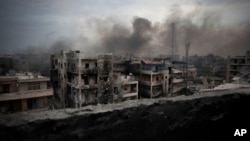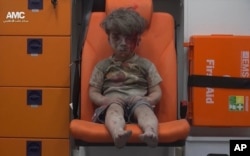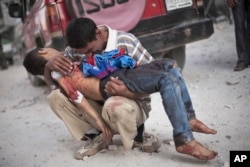Asked on MSNBC's "Morning Joe" program on Thursday what he would do about the conflict in Aleppo, U.S. Libertarian Party presidential candidate Gary Johnson replied, "what is Aleppo?''
In the U.S., his comments sparked debate over the lack of foreign policy discussions in these presidential elections. But for many Syrians it was an opportunity to vent their frustration and bring the world's attention to one of Syria's oldest cities, and the scene of some of the fiercest fighting in the five-year civil war.
Using the hashtag, #WhatIsAleppo, Facebook and Twitter users shared stories of its ancient history and its modern woes. Some posted pictures of Aleppo's beautiful narrow streets and the 13th century citadel that towers over the city.
Others shared images of the destruction that has beset Aleppo, particularly its rebel-held neighborhoods, which were recently described by one rebel fighter as "like walking into Hiroshima.''
Many posted pictures of Aleppo's residents, such as the iconic image of five-year-old Omran Daqneesh, photographed sitting on an orange chair, covered in dust, his pale face smeared with blood following an airstrike.
The population of Syria's largest city has fallen from 3.1 million in 2011 to an estimated 2 million today, as families have fled four years of violence and hardship. Once Syria's commercial center, large parts of Aleppo are under siege and food and basic necessities are often scarce, dependent on humanitarian aid convoys that arrive only after complex international negotiations. Aleppo's renowned textile factories have been destroyed.
The city's rich cultural and religious mix of Christians, Muslims, Armenians and Kurds has been torn apart by the conflict.
"If you are wondering #WhatISAleppo: More than 100 cases of suffocation in al-Sukkari neighborhood, #Aleppo, in a chlorine gas #BarrelBombs attack,'' the Syrian Coalition, an exiled opposition group, tweeted. It referred to a suspected toxic gas attack by government helicopters on Tuesday that killed two people and left at least 80 with breathing problems. The government on Thursday denied using the toxic gas.
For Wissam Zarqa, a 34-year-old resident of rebel-held Aleppo, the city is the embodiment of the "will to live.'' He returned to his hometown from Saudi Arabia last year and gives English classes to children whose schools have long closed.
"There is something magical about the return of life to an area after a barrel bomb has just been dropped,'' he told The Associated Press via WhatsApp messages. "When I first returned to Aleppo 16 months ago, a missile hit the last floor of the building I live in. Half an hour later, the kids had finished cleaning the street outside the building.''
Unsurprisingly when its neighborhoods are physically separated by gunmen and sandbags, the people of Aleppo are divided over what their city is.
"#WhatIsAleppo. It was an industrial hub of Syria until rebels invaded, looted her factories & smuggled them to Turkey,'' tweeted Bassem, a self-proclaimed secular Syrian with a large following on Twitter.
Aida, a 78-year-old native of Aleppo who left her hometown four decades ago and has not returned since the conflict began, pointed to her city's heritage as one of the oldest continuously inhabited towns. Unlike many other ancient cities, its location has never changed.
"Aleppo has always circled and hovered around the citadel. It never changed axis. It grows with the same citadel at the center,'' she said. She did not want to give her last name to protect her privacy.
The citadel, at least, is damaged but still standing.
But not for the first time in its long history, Aleppo finds itself torn between international powers. Turkey is a main supporter of the city's rebel groups, and has sent its military to Aleppo province to fight Islamic State group extremists and rival Kurdish rebels. Russia and Iran are supporting the Syrian government's bid to gain control over the city.
The U.S. and Russia are locked in protracted negotiations over a cease-fire in the city, after a previous truce deal collapsed in Aleppo in April.
In the meantime, the International Committee for the Red Cross describes Aleppo simply as "one of the most devastating urban conflicts in modern times.''











